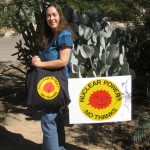
CNSC lures Ontario communities with bogus promise of big bucks.
by Penney Kome
From December 3 – 5, the Canadian Nuclear Safety Commission is holding hearings in Courtice, Ontario, with an unprecedented three different items on the agenda. The meetings had to be postponed from September because of the number of intervenors. Ninety groups or individuals will present in person; at least as many have submitted written presentations.
NorthWatch researcher Brennain Lloyd talks about issues now before the CNSC.

In this exclusive SGN video interview, Brennain Lloyd of NorthWatch describes the issues and dynamics involved with these hearings. Intervenors have ten minutes to address:
- re-licensing the Darlington nuclear reactor;
- re-licensing a high-level (fuel grade) waste facility; and
- a proposal to refurbish Darlington.
For many environmental groups, the radioactive waste issue is urgent. Currently, the wastes are “imperfectly stored” at the reactor station, said Lloyd. She cited a decades-long hunt for the perfect geological formation that would isolate fuel waste in perpetuity. Now the regulators have abandoned that hunt, and “any rock will do.” One proposal is to bury low and medium level wastes deep below the surface of the Bruce generating station, on the shore of Lake Huron.
As well, the CNSC has invited Ontario small cities and townships to participate in a “National Infrastructure Project” — otherwise known as a nuclear dump — advertised as being worth $16 – 24 billion. Twenty-one communities have agreed to be studied as potentially the site for high-level nuclear waste — mostly without the local people knowing anything about it.
Lloyd said that the CNSC is trying to reassure municipal councils that the radioactive material decomposes over time, so that eventually there will be no radioactivity left. Two key factors are omitted from presentations, however. The first is that decomposition can take centuries, if not millennia. The second is that decomposition means the radioactivity is leaving the material — and potentially going into the local air and water.
© Copyright 2012 Penney Kome, All rights Reserved. Written For: StraightGoods.ca3 Responses to ““Infrastructure” proposals really nuclear dumps”
Sorry, the comment form is closed at this time.

 Penney Kome is an award-winning author and journalist who has published six books with major publishers. She is also the Editor of Straight Goods.
She is co-editor with Patrick Crean of Peace: A Dream Unfolding (1986, Sierra Club Books). She started marching against the atomic bomb when the placards were taller than she was, and she emigrated from the US to Canada in protest against the war in Vietnam.
Penney Kome is an award-winning author and journalist who has published six books with major publishers. She is also the Editor of Straight Goods.
She is co-editor with Patrick Crean of Peace: A Dream Unfolding (1986, Sierra Club Books). She started marching against the atomic bomb when the placards were taller than she was, and she emigrated from the US to Canada in protest against the war in Vietnam.
21 communities and how many politicians? Because 'progressives' keep telling us to vote in order to change things. Go vote for politicians who preside over class warfare and a war against nature and our liveable earth, is the instruction. It's not a plan, in my view. Haven't see seen enough of how politics today works? The job description of a politician today is:
subscribe to, embrace and promote fascism
If corporations, and (let's face it), those who comprise their management, are psychopathic, which I believe has been well established, then a system in which the political class works together with the capitalist class, running everything in an exploitative way, while telling the exploited and/or superfluous that they have democracy and needn't look for it, even when that democracy is resulting in destruction all around, then perhaps electoral politics today isn't the answer. Unless we are talking about attacking 'that'.
You aren't attacking 'that' by weakly supporting the least criminal political party getting in on the anti-civil society scam either.
Sorry Penney, but this is something that regularly irks me as a radiation scientist. (I previously practised as a radiation therapist and also did a MSc degree researching ways of making radiation therapy for cancer treatments more effective)
When people claim that radioactive material lasts millenia and that it is emitting dangerous radiation, they are missing two key points:
– First, materials that are highly radioactive decay (not the same as decomposing) quite quickly, so most of it goes away in a short period of time. The stuff that lasts a long time does so because they are less radioactive. It's just like pouring water out of a pitcher – pour fast, gone fast. If it's going to stay for a long time, you're obviously pouring slowly.
– Second, low-level radioactive material (the slow pour stuff) isn't necessarily dangerous. We're exposed to a relatively large amount of natural background radiation every year as it is, the extra contribution from the stuff you're talking about is so insignificant in comparison.
All in all, the proposals aren't dumps at all. They're heavily-engineered underground repositories… there's a not-so-subtle difference between landfilling something with radioactive goo and carefully storing sealed casks of spent fuel 100 or so metres underground.
[…] Read story Share this:TwitterFacebookLike this:LikeBe the first to like this. […]